Lamb producers will receive real-time feedback on their carcass quality through a new electronic grading system
A new electronic grading system will move Canada’s lamb industry from grading with a ruler in a cold room into the 21st century.
“It’s hardly a way to run an industry,” said Terry Ackerman, chief executive officer of the Canadian Lamb Producers Cooperative, of the current system.
Ottawa is giving the co-op $1.4 million to develop the new grading system, which will be implemented this fall in two processing plants, one in Ontario and one in Alberta.
The goal is to “reward producers for good-quality lambs,” said Ackerman. The co-op will be working with researchers at Agriculture and Agri-Food Canada in Lacombe to develop an algorithm for the system, using 500 lamb carcasses to evaluate different factors affecting grade.
Read Also

Mosquito-borne virus could be devastating to sheep breeding operations
Cache Valley virus, a mosquito-borne disease that infects small ruminants, could be a devastating hit to small operations.
“In effect, we’ll be able to measure any kind of lamb in Canada and get a good reading on how much meat is actually on the lamb carcass,” said Ackerman. Lambs today are mostly bought on appearance and weight, and there’s no unambiguous way to precisely know how well a farm’s genetics and feed management systems are working.
“In effect, it’s a crapshoot,” said Ackerman. “There’s a huge amount of difference between what a lamb looks like and the meat that will come off the carcass.”
The new system will provide feedback on the quality of carcasses in real time as the lamb is being graded.
“They will also get a grid and compare their lambs against all the other lambs being graded,” he said. “This has never been done before in the world.”
Radio-frequency identification tags will be used to track animals from the farm right through the plants and that traceability will help open markets in the EU, said Ackerman.
“These markets will now open up because of the grading system. We can trace, and we know the grade of the lambs,” he said.
Federal researchers at Lacombe have been working with the Alberta Lamb Producers organization and Alberta Agriculture and Rural Development to find a way to better predict lean meat yield.
“Not all grading systems are alike throughout the world, so we want to see if we can include other factors in a grading system to improve carcass and meat quality and, really, uniformity of the lamb carcasses in Canada,” said research scientist Jennifer Aalhus.
The project will also look at production factors that contribute to variability in lamb carcass quality.
“If (producers) are not getting the results they want in terms of the grading system, they could be changing their production and management to get what they’re after in terms of grades,” she said.
Once completed, the project will complement the new electronic grading system, with results that have “ramifications right across the country,” said Ackerman.
“It’s not something that’s a study of a study,” he said. “It’s something that will actually be in place, with real results.”














